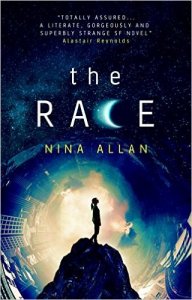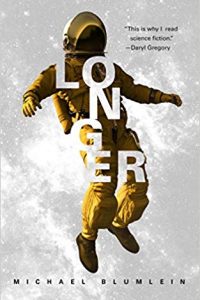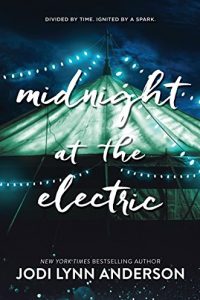Gary K. Wolfe Reviews Nina Allan’s The Race
The Race, Nina Allan (Newcon Press 978-1907069703, £12.99, 256pp, tp) August 2014. Cover by Ben Baldwin. (Titan Books 9781785650369, $14.95 US, 448pp, tp) July 2016.
 Nina Allan has seemed on the verge of novel-making for much of her career, with novellas such as Spin and Harlequin and linked story collections like The Silver Wind and Stardust, the latter consisting of stories that loop and weave around each other so cleverly that, by simply attaching a few cables here and there, it could easily be read as a novel. Her first full-length novel, The Race, shares something of the choreography of that book, consisting of discrete narratives and voices which converse with each other in ways that aren’t immediately apparent, and it makes enough metafictional U-turns that even describing the second chapter seems to risk a call from the spoiler police – so let’s see how we should handle this.
Nina Allan has seemed on the verge of novel-making for much of her career, with novellas such as Spin and Harlequin and linked story collections like The Silver Wind and Stardust, the latter consisting of stories that loop and weave around each other so cleverly that, by simply attaching a few cables here and there, it could easily be read as a novel. Her first full-length novel, The Race, shares something of the choreography of that book, consisting of discrete narratives and voices which converse with each other in ways that aren’t immediately apparent, and it makes enough metafictional U-turns that even describing the second chapter seems to risk a call from the spoiler police – so let’s see how we should handle this.
First of all, the new Titan edition of The Race adds an ‘‘appendix’’ with a novella’s worth of new material not in the original 2014 edition, which was nominated for the Campbell and British Fantasy Awards – though as far as I can tell the central narrative remains the same. The long, novella-length opening chapter quickly establishes SF bona fides and explains, at least partially, the title. The narrator Jenna lives in Sapphire, a hardscrabble town near the Romney Marshes in southeast England, which were turned into a toxic wasteland through fracking and drained more than a century earlier. Now the town’s economy depends on the nominally illegal sport of racing smartdogs, greyhounds tweaked to advanced intelligence through human DNA, and which develop almost psychic connections with their human ‘‘runners,’’ thanks to chip implants (also illegal) in the runners’ brains. It’s no secret that the first smartdogs were developed for military purposes, but the real focus of this opening chapter is less on the dogs than on Jenna’s own story. Abandoned as a teenager by her mother, she lives in fear – or at least apprehension – of her violent and disturbed brother Del, a sometime drug dealer whose ambition to be a runner was thwarted when he was rejected for the necessary brain implant. The one bright spot in his life is his daughter Luz Maree, or Lumey, who seems able to communicate with the dogs – especially a prize hound name Limlasker – even without an implant. When she is kidnapped for ransom because of Del’s drug-running debts, he hatches a scheme that reads like a dark parody of every horse movie ever made: he’ll race Limlasker to win a longshot jackpot to pay off the debt. Of course, none of this works out quite like National Velvet, and the story ends with a number of threads deliberately left dangling.
Next, we’re introduced to a writer named Christy Peller, also abandoned by her mom at 15, also in fear of her brother Derek, who had been expelled from school and works with his father in his rubbish-hauling business. While Christy’s connection to Jenna’s tale is made clear early on, her own story centers around her troubled relationship with Derek, and her fear that he may have killed his girlfriend Linda after learning that she was dumping him for her old boyfriend Alex, who seems like a minor figure until we learn that the next chapter is his story. He’s been invited by Christy to visit her, and takes an interest in her collection of short stories, some of which seem rather familiar to him. Then the point of view abruptly shifts again to the story of Maree – the kidnapped Lumey from that first chapter – who is now several years older and part of a secret government program with distinctly science fictional overtones. She lives in a diminished world in which even sea travel is hazardous because of ‘‘whale convoys,’’ and remembers almost nothing of her earlier life, except her closeness to the dog Limlasker. Allan then concludes the book with a tantalizing selection of fragments not included in the original 2014 edition: a long story by Christy concerning Maree, a program involving extraterrestrial communication, and an artist named Laura, who suspected she might be living in a parallel universe and who in fact had disappeared, the whole thing concluding with news items: journal extracts and exhibit catalog descriptions of Laura’s work, even a bit of a radio play based on these characters. While this added material doesn’t substantially alter the plot’s conclusion, it does invite us to reconsider earlier material in a substantially new light.
And yet the more The Race seems to fragment into multiple narratives and multiple narrators – who is exactly telling whose story at any moment, and which stories nestle in other stories? – and the more it seems to hover between genres, with fantasy place names like Crimond and Thalia mixed in with familiar geography and real environmental collapse, or with allusions to everything from James Herbert’s Rats to Doris Lessing’s Memoirs of a Survivor, the more it weaves its own hypnotic dream-like spell, and the more oddly unified it begins to feel as a kind of psychic landscape. For all its intricate narrative linkages and loopbacks, the novel presents us with a world which is thoroughly seductive and ominously credible, and a degree of narrative sophistication as impressive as anything I’ve seen in recent SF.








